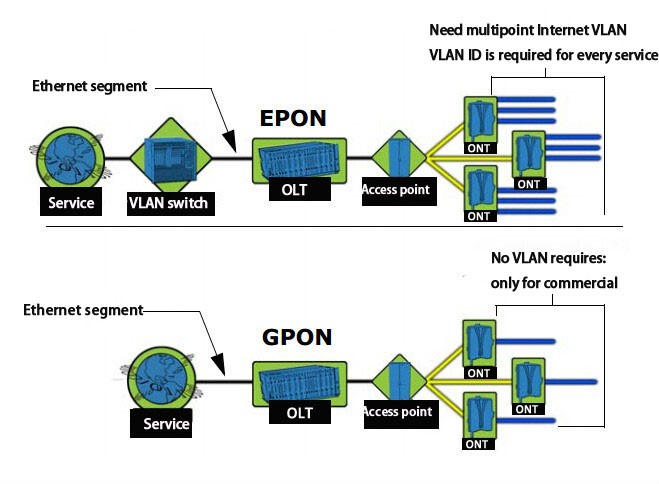The advent of GEPON technology, which allows direct transmission of Ethernet traffic through optics, was a logical development of the concept of a comprehensive, end-to-end use of Ethernet equipment on the networks of telecom operators. The procedures for this technology are described in the IEEE 802.3ah standard, released in 2004. This technology uses Ethernet packets at speeds up to 1 Gbit / s in both directions to transmit traffic. The topology of the GEPON network can be any: a bus, a star, a combination of them and even a ring for redundancy, which is implemented using automatic optical switches. Among the advantages of this technology can be noted the low cost of solutions based on it. To date, about 20 million GEPON ports have been installed, mostly in Southeast Asia.
Another gigabit PON standard that describes GPON technology was adopted by ITU-T in 2005 and received the G.984 number. It is based on the use of a specialized protocol created on the basis of SDH standards. At the same time, to ensure efficient use of the communication channel, dynamic redistribution of the bandwidth is maintained while maintaining the SDH frame structure. The standard allows traffic to be transmitted in a symmetric and asymmetric ratio of speeds, reaching values up to 2.5 Gbit / s. The advantages of GPON include the presence of built-in QoS mechanisms for transmitting video and audio traffic. This technology is most widely used in North America and Europe.
The main differences between GPON and GEPON are the greater downstream band (DownStream, DS) for GPON: 2.5G versus 1.25G for GEPON. It also has a different frame structure: in GEPON it is as similar to Ethernet as possible, while in GPON it is more complex and reminds SDH more.

The choice between GPON or GEPON-based solutions for building an operator access network probably depends on other factors than the technical characteristics and functionality of the equipment. Despite the fact that GPON is able to provide a large bandwidth, this does not give special advantages in terms of the quality of services received by subscribers. On the side of GEPON technology, seamless Ethernet integration with subscriber terminals and core networks.
The undoubted advantages of GPON and GEPON technologies is the possibility of a significant removal of the subscriber’s connection point from the central device, as well as a guaranteed high transmission speed. Optical Gigabit Ethernet should be considered the only competitor of these gigabit technologies; however its topology requires intermediate active devices in contrast to passive PON network splitters. Do not neglect the lesser need for an optical cable. Although, as already noted, the cost of this cable has decreased markedly, but there will always be the problem of laying it in cable ducts.

